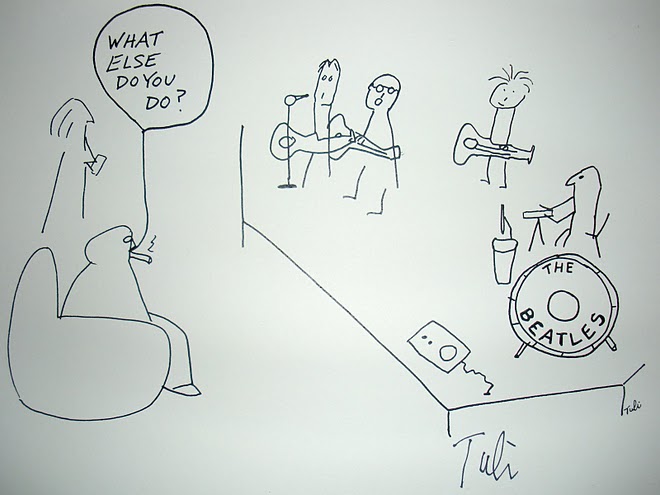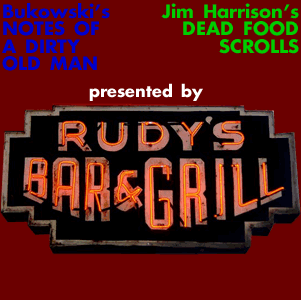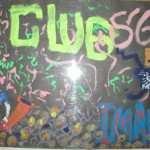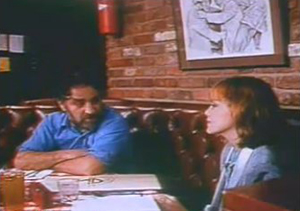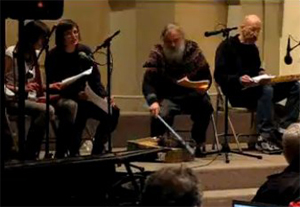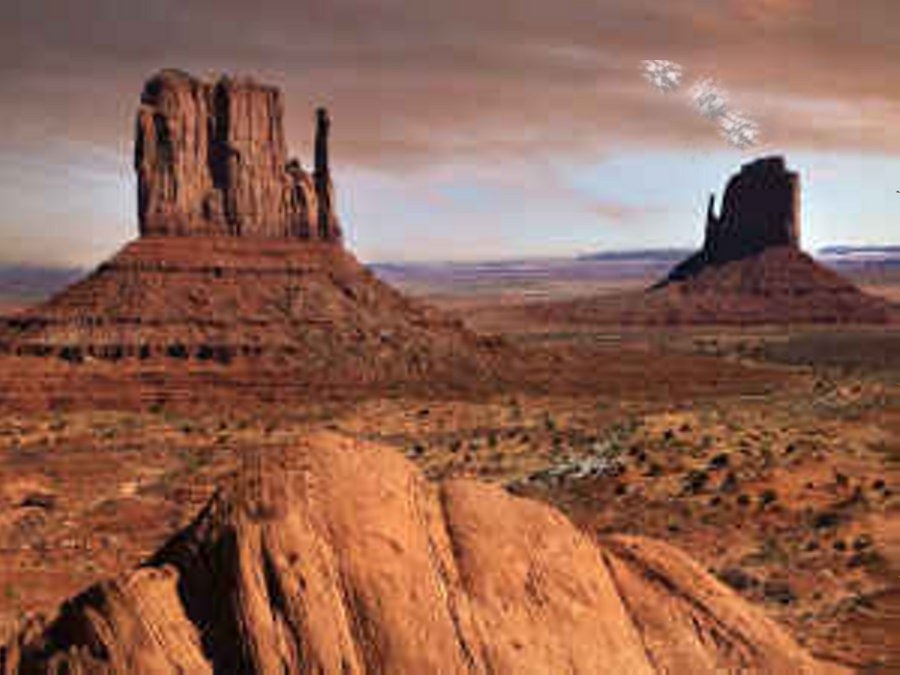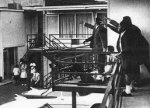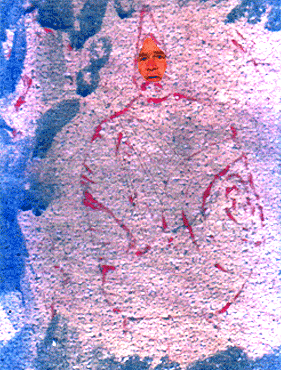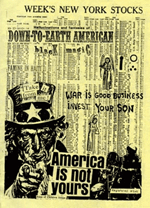Renfreu Neff’sSLEEPING AT THE MOVIES
Naps are God’s way of editing.
As buzz over the awards nominations subsides to yawns, January rose from the debris left from The Tourist, Burlesque, and Country Strong, all nominees in the Golden Globes’ vast and unfathomable selection process, the grievance from this quarter was the omission of Clash of the Titans. Is it possible that none of the HFP folk remembered Ralph Fiennes’ Hades, Lord of the Underworld, tooling about inside a glitter-spewing ball of fuzz, a sort of Hairball One, to face-offs with Zeus, played by the indomitable Liam Neeson, the only English-speaking actor capable of challenging Fiennes in rolling his ar’s around the line “Rrrlease the krrraken!”, on being told that the armies of Hades have launched an attack? The Kraken, I’m told, comes from Norse mythology & is completely miscast here, and in a quick cut-away, the kraken is shown to resemble a large door-stop. That aside, once the armies clash – and clash they do, with sword-wielding toga-ed warriors in combat with lumbering robots on a battlefield strewn with spare parts, this is clearly Golden Globe material. Fortunately for the Hollywood Foreign Press, its cred was restored by giving the Best Supporting Actor award to Christian Bale, the sexiest nutjob alive.
Bernardo Bertolucci was in New York this winter for the opening of a complete retrospective of his films at the Museum of Modern Art. Co-produced by Cinecitti Luce Roma, which provided new prints with color and sound correction supervised by cinematographers who had worked on them in the past, this was an enormous undertaking on behalf of a director arguably with more masterpieces than any other living filmmaker. The event kicked off with a press conference at the Italian Cultural Institute where il Maestro (the honorific extended after the passing of Fellini) — due to back problems in recent years — arrived in a wheelchair to enthusiastic applause. Dressed in the off-hand casual style that ‘s innate to Italian men and topped by the universal baseball cap, he listened attentively to the lengthy, often florid welcoming speeches by various dignitaries, his expression shifting from puzzlement to What-me-worry? resignation. Formalities were finally broken by the entrance of Roberto Cicutto, president of Cinecitta, cursing the traffic from JFK as he rushed forward joking that he had to come all the way to New York to finally meet Bernardo because Jeremy Thomas, Bertolucci’s long-time producer, was too jealous to introduce them in Rome.
Seated at a table in front of the room, the director tapped his watch and chided the executive on being “exactly forty minutes late.” Some brief remarks from Cicutto, and the atmosphere settled into a congenial exchange between director and the press, during which, in response to a comment regarding the beautiful, dreamlike quality of the films, Vittorio Storaro, the only cinematographer to have won three Academy Awards, was introduced. The subject of the “sacred monsters” arose, and the director recalled working with Robert De Niro (Novecento), who wanted every backstory detail on his character, even wanting to be taken to the town where he might have grown up. Depardieu napped through it all and had to be awakened and pushed onto the set.
And, of course, there was Marlon Brando, but first to MoMA’s sold-out series. The 19-film program opened with The Conformist, Bertolucci’s masterful portrait of a man (Jean-Louis Trintignant) whose drive for political acceptance leads to a marriage of bourgeois accommodation and ultimately into betrayal and murder. Set in the rising Fascist society of Italy in the 30’s, in the stylized elegance of the period’s Art Deco neoclassicism, this seamless placement of character complexity within an environment saturated in visual authenticity, a hallmark of Bertolucci ‘s cinema, no matter the narrative context. Detractors tend to dismiss him for making “pretty pictures”, but admiring defenders — and judging from MoMA’s capacity filled screenings, they outnumber the skeptics — will counter that this is Cinema, what the medium of grand images ought to be. It might be viewed as the stylish twin of Frederick Zimmerman’s austere black-white documentaries with the camera’s slow, probing movement accompanied only by ambient sound. In his commentary on Bertolucci vis à vis The Conformist (“The New Biographical of Film”), British film writer/historian David Thomson refers to it as “the silent gap between substance and style”. Precisely.
I passed on revisiting Last Tango In Paris, opting instead for a document-ary on the making of it by Serge July and Bruce Nuytens. Comprised of interviews with the director, cinematographer Vittorio Storaro and Maria Schneider intercut with sequences from the notorious film, it was nearly as revealing as the film itself. The part of Paul was first offered to Belmondo, who rejected it outright, saying that he wouldn’t do pornography. Alain Delon was then approached; he would do it, if he could produce it. With two major European stars out of the running (Where was Mastroianni?), someone suggested that Brando, whose career was in free-fall after three flops in a row, might be willing to do it. But Brando’s reputation for being difficult was well known, and he had more experience than Bertolucci at that time, so there was reluctance on the latter’s part. Nevertheless, encouraged by the sharp decline of the actor’s career, the part was offered and Brando accepted, and aside from his strict adherence to union work rules (he left the set promptly at 5:00 and refused to film on weekends) and his habit of not memorized his lines, he was a sweet pea. Sort of.
A pale and dispirited Maria Schneider recounts her unpleasant experience of exploitation; first by her wildly unpredictable co-star who scribbled is lines on pieces of paper taped around the set and strayed off-script (the shocking “pass the butter” improvisation is duly cited). She was also being exploited by the director, who made her work long hours and weekends to make up for time lost without Brando, while telling her that without the film she would be nothing. At the gala Paris premiere, with everyone turned out for the movie swathed in rumor and notoriety, the only one who spoke to her was Jean Seberg — whose own career would be limbo-ed by Godard. Because of Last Tango’s lurid publicity in Italy and abroad, Italian authorities, prodded by the Vatican, denied Bertolucci the right to vote for two years.
Screenings continued apace, two daily without chronological sequence, the earlier politically inspired films alongside the later features that made Bertolucci a contender in the league of International Directors — Last Tango In Paris (’76), Novecento (’76), The Last Emperor (’87), The Sheltering Sky (’90); perfect for a New York day with three feet of snow and temperatures nudging twenty), the near miss of Little Buddha — and with laudable curatorial finesse, Before The Revolution (’64, restored in brilliant black/white) was screened on the next to last day; a light-bulb moment here, illuminating it as the thematic prequel of the opening night’s The Conformist. The retrospective concluded with Stealing Beauty (’96) — agreed, a pretty picture — and The Dreamers (2003), with its shadow of Novecento.
For me, the real highlight of the program was la Via del Petrolio (Oil), a three-part documentary made for Italian television in 1966–67. We see how oil is extracted from the ground in the Middle East and Persian Gulf, pumped into huge tankers for transport from Sinai to the Mediterranean port of Genoa, where it “goes back into the ground”, the narrator tells us, off-loaded into pipelines that carry it to refineries throughout Central Europe.
Ordinarily, black & white movies send me right to sleep, and indeed some soft snores were audible, but I found this three-hour film riveting. A major rediscovery at the Venice Film Festival in 1977, it was shown at MoMA with Il Canale, a hypnotically surreal 12-minute pause (color) in a drowsy residential area of Suez, a world dwarfed by enormous tankers, silent apparitions, gliding pass every six minutes, twenty-four hours a day.
People bond at retrospectives. The hardcore regulars are observed early on, acknowledged with non-intrusive nods before venturing opinions/ sharing agreements on a film’s merits. At Partner (’68), I found myself seated next to a young man (presumably a student) engrossed in a paperback of Camus’ short pieces. Afterward, we met by chance in the Metro and exchanged opinions. He said he’d loved it, I nodded and walked on. I’d loved it, too, at first sight, years ago when its experimental self-indulgence and rebellious exuberance were fresh (and so was I), but now I’d found it outdated and tiresome. I felt nostalgic for the time when I’d liked it.
For those immersed in Bertolucci at MoMA, benignly deluded creatures believing their first language somehow became Italian, The Leopard, Luchino Visconti’s opulent historical adaptation of Giuseppe di Lampedusa’s epic novel, is being shown downtown at Film Forum in a brand new digitally “cleaned” 35mm restoration. It’s also playing to capacity audiences, so maybe it will be held over again. Just call up and bother them to hold it over another week or two, so that the Bertolucci contingent can air out and get there. They’ll recognize The Leopard, made in1963, as the historical pre-prequel of Before the Revolution.
IFC (6th below West 4th) is another theatre to annoy, if you want to see French director Gaspar Noe’s (as in “no way”) Enter The Void, this original version being twenty minutes longer than the previously released cut. His two earlier films, I Stand Alone (1998) and Irreversible (in 2002), were, put mildly, disturbing, but Enter The Void is a sensory juggernaut that jars the mind and leaves no thought unturned. Loosely taken from The Tibetan Book Of The Dead, one person’s bardo being another person’s movie, Void’s appeal is to those who appreciate the finer points of nihilism and vengeance, without car chases, knowing that there are no cute meets in Hell. Not a “date movie” (?) it’s best to go alone and enjoy your own demons without “sharing” (?). Don’t you hate people who tell you movies? I’m just saying go see it for (and by) yourself. A reviewer’s job well done.
Renfreu Neff interviewed John Giorno, or the other way around, in LOVE & SLEEZE at http://yrstruly.org/valentine/wordpress/?page_id=24 Her previous column of Sleeping At The Movies can be found at http://smokesignalsmag.com/7/?p=218



